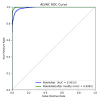Deep Learning-Based Diagnosis Algorithm for Alzheimer's Disease
- PMID: 39728230
- PMCID: PMC11728444
- DOI: 10.3390/jimaging10120333
Deep Learning-Based Diagnosis Algorithm for Alzheimer's Disease
Abstract
Alzheimer's disease (AD), a degenerative condition affecting the central nervous system, has witnessed a notable rise in prevalence along with the increasing aging population. In recent years, the integration of cutting-edge medical imaging technologies with forefront theories in artificial intelligence has dramatically enhanced the efficiency of identifying and diagnosing brain diseases such as AD. This paper presents an innovative two-stage automatic auxiliary diagnosis algorithm for AD, based on an improved 3D DenseNet segmentation model and an improved MobileNetV3 classification model applied to brain MR images. In the segmentation network, the backbone network was simplified, the activation function and loss function were replaced, and the 3D GAM attention mechanism was introduced. In the classification network, firstly, the CA attention mechanism was added to enhance the model's ability to capture positional information of disease features; secondly, dilated convolutions were introduced to extract richer features from the input feature maps; and finally, the fully connected layer of MobileNetV3 was modified and the idea of transfer learning was adopted to improve the model's feature extraction capability. The results of the study showed that the proposed approach achieved classification accuracies of 97.85% for AD/NC, 95.31% for MCI/NC, 93.96% for AD/MCI, and 92.63% for AD/MCI/NC, respectively, which were 3.1, 2.8, 2.6, and 2.8 percentage points higher than before the improvement. Comparative and ablation experiments have validated the proposed classification performance of this method, demonstrating its capability to facilitate an accurate and efficient automated auxiliary diagnosis of AD, offering a deep learning-based solution for it.
Keywords: Alzheimer’s disease; MRI; attention mechanism; automatic auxiliary diagnosis; deep learning.
Conflict of interest statement
The authors declare no conflicts of interest.
Figures
















Similar articles
-
A multi-model deep convolutional neural network for automatic hippocampus segmentation and classification in Alzheimer's disease.Neuroimage. 2020 Mar;208:116459. doi: 10.1016/j.neuroimage.2019.116459. Epub 2019 Dec 16. Neuroimage. 2020. PMID: 31837471
-
A 3D densely connected convolution neural network with connection-wise attention mechanism for Alzheimer's disease classification.Magn Reson Imaging. 2021 May;78:119-126. doi: 10.1016/j.mri.2021.02.001. Epub 2021 Feb 13. Magn Reson Imaging. 2021. PMID: 33588019
-
Development and validation of an automatic classification algorithm for the diagnosis of Alzheimer's disease using a high-performance interpretable deep learning network.Eur Radiol. 2023 Nov;33(11):7992-8001. doi: 10.1007/s00330-023-09708-8. Epub 2023 May 12. Eur Radiol. 2023. PMID: 37170031
-
Deep Learning in Alzheimer's Disease: Diagnostic Classification and Prognostic Prediction Using Neuroimaging Data.Front Aging Neurosci. 2019 Aug 20;11:220. doi: 10.3389/fnagi.2019.00220. eCollection 2019. Front Aging Neurosci. 2019. PMID: 31481890 Free PMC article.
-
A review on Alzheimer's disease classification from normal controls and mild cognitive impairment using structural MR images.J Neurosci Methods. 2023 Jan 15;384:109745. doi: 10.1016/j.jneumeth.2022.109745. Epub 2022 Nov 14. J Neurosci Methods. 2023. PMID: 36395961 Review.
Cited by
-
3D-NASE: A Novel 3D CT Nasal Attention-Based Segmentation Ensemble.J Imaging. 2025 May 7;11(5):148. doi: 10.3390/jimaging11050148. J Imaging. 2025. PMID: 40423005 Free PMC article.
-
Evaluating the Impact of 2D MRI Slice Orientation and Location on Alzheimer's Disease Diagnosis Using a Lightweight Convolutional Neural Network.J Imaging. 2025 Aug 5;11(8):260. doi: 10.3390/jimaging11080260. J Imaging. 2025. PMID: 40863470 Free PMC article.
References
-
- Jia J., Li A. Research Progress in social alienation in early Alzheimer’s disease patients. Chin. J. Pract. Neurol. Disord. 2024;27:523–528.
-
- Pang L., Zhou X., Sun Y., Li J. Focused on sleep disorders and behavioral subsyndrome analysis in Alzheimer’s disease patients. Public Health Prev. Med. 2022;33:154–157.
-
- Sun G.A.H., Hu X. Study on the characteristics of pragmatic ability erosion loss in patients with Alzheimer’s disease. Chin. J. Hear. Lang. Rehabil. 2022;20:314–316.
Grants and funding
LinkOut - more resources
Full Text Sources

